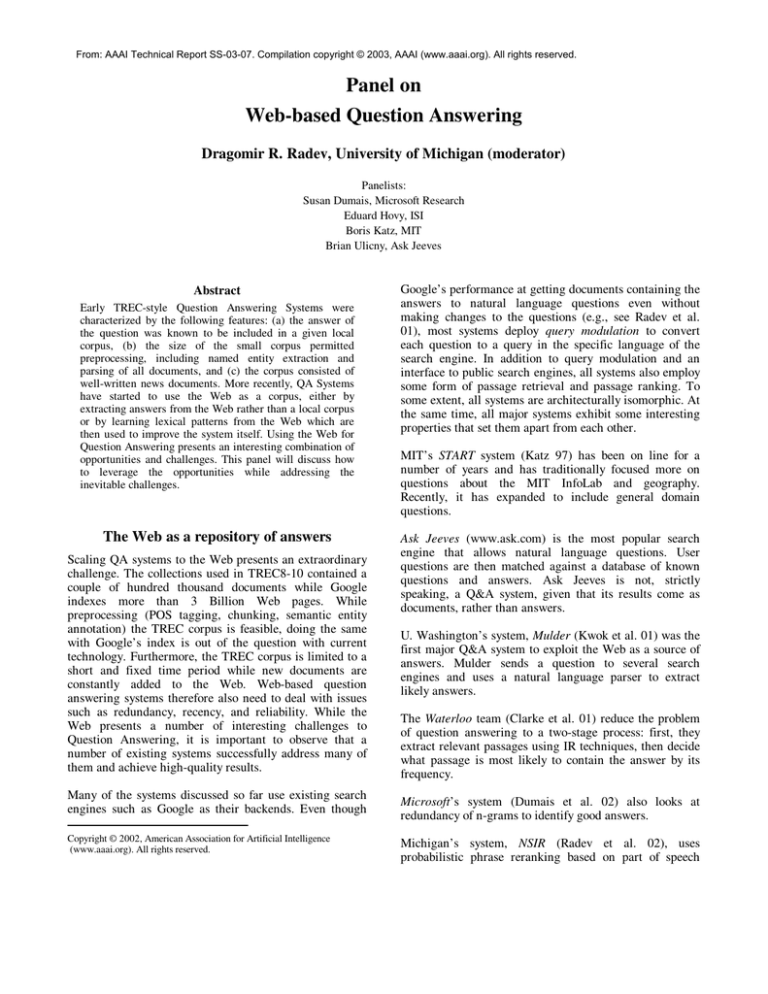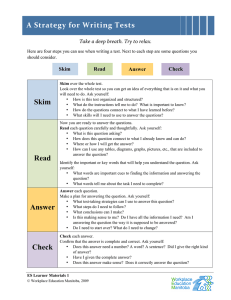
From: AAAI Technical Report SS-03-07. Compilation copyright © 2003, AAAI (www.aaai.org). All rights reserved.
Panel on
Web-based Question Answering
Dragomir R. Radev, University of Michigan (moderator)
Panelists:
Susan Dumais, Microsoft Research
Eduard Hovy, ISI
Boris Katz, MIT
Brian Ulicny, Ask Jeeves
Abstract
Early TREC-style Question Answering Systems were
characterized by the following features: (a) the answer of
the question was known to be included in a given local
corpus, (b) the size of the small corpus permitted
preprocessing, including named entity extraction and
parsing of all documents, and (c) the corpus consisted of
well-written news documents. More recently, QA Systems
have started to use the Web as a corpus, either by
extracting answers from the Web rather than a local corpus
or by learning lexical patterns from the Web which are
then used to improve the system itself. Using the Web for
Question Answering presents an interesting combination of
opportunities and challenges. This panel will discuss how
to leverage the opportunities while addressing the
inevitable challenges.
The Web as a repository of answers
Scaling QA systems to the Web presents an extraordinary
challenge. The collections used in TREC8-10 contained a
couple of hundred thousand documents while Google
indexes more than 3 Billion Web pages. While
preprocessing (POS tagging, chunking, semantic entity
annotation) the TREC corpus is feasible, doing the same
with Google’s index is out of the question with current
technology. Furthermore, the TREC corpus is limited to a
short and fixed time period while new documents are
constantly added to the Web. Web-based question
answering systems therefore also need to deal with issues
such as redundancy, recency, and reliability. While the
Web presents a number of interesting challenges to
Question Answering, it is important to observe that a
number of existing systems successfully address many of
them and achieve high-quality results.
Many of the systems discussed so far use existing search
engines such as Google as their backends. Even though
Copyright © 2002, American Association for Artificial Intelligence
(www.aaai.org). All rights reserved.
Google’s performance at getting documents containing the
answers to natural language questions even without
making changes to the questions (e.g., see Radev et al.
01), most systems deploy query modulation to convert
each question to a query in the specific language of the
search engine. In addition to query modulation and an
interface to public search engines, all systems also employ
some form of passage retrieval and passage ranking. To
some extent, all systems are architecturally isomorphic. At
the same time, all major systems exhibit some interesting
properties that set them apart from each other.
MIT’s START system (Katz 97) has been on line for a
number of years and has traditionally focused more on
questions about the MIT InfoLab and geography.
Recently, it has expanded to include general domain
questions.
Ask Jeeves (www.ask.com) is the most popular search
engine that allows natural language questions. User
questions are then matched against a database of known
questions and answers. Ask Jeeves is not, strictly
speaking, a Q&A system, given that its results come as
documents, rather than answers.
U. Washington’s system, Mulder (Kwok et al. 01) was the
first major Q&A system to exploit the Web as a source of
answers. Mulder sends a question to several search
engines and uses a natural language parser to extract
likely answers.
The Waterloo team (Clarke et al. 01) reduce the problem
of question answering to a two-stage process: first, they
extract relevant passages using IR techniques, then decide
what passage is most likely to contain the answer by its
frequency.
Microsoft’s system (Dumais et al. 02) also looks at
redundancy of n-grams to identify good answers.
Michigan’s system, NSIR (Radev et al. 02), uses
probabilistic phrase reranking based on part of speech
patterns to identify the semantic type of a potential answer
phrase.
InsightSoft’s approach (Soubbotin 01) makes use of
automatically extracted patterns to identify likely passages
given a question. For example, a pattern like “capitalized
word ‘in’ digit digit digit digit ‘born’” is indicative of a
date-of-birth question.
Ravichandran and Hovy from ISI (Ravichandran and Hovy
02) go to the Web to extract patterns of the style suggested
by Soubbotin. They send queries containing known
question-answer pairs to the Web and retrieve phrases that
are indicative of a relation between the question and the
answer words.
While the overall architecture of Web-based Q&A systems
is fairly standard, the amount of Natural Language
Processing techniques used varies from system to system.
An interesting open question therefore is to what extent
NLP components help achieve higher performance.
References
Charles Clarke, Gordon Cormack, and Thomas Lynam.
Exploiting Redundancy in Question Answering. SIGIR
2001, New Orleans, LA.
Susan Dumais, Michele Banko, Eric Brill, Jimmy Lin, and
Andrew Ng. Web Question Answering: Is More Always
Better? SIGIR 2003, Tampere, Finland.
Boris Katz. From Sentence Processing to Information
Access on the World Wide Web. AAAI Spring Symposium
on Natural Language Processing for the Web 1997,
Stanford, CA.
Cody Kwok, Oren Etzioni, and Daniel Weld. Scaling
Question Answering Systems to the Web. WWW 2001,
Hong Kong.
Discussion questions
Dragomir Radev, Kelsey Libner, and Weiguo Fan. Getting
Answers to Natural Language Queries on the Web.
JASIST 53(5), January 2001.
To ensure a focused discussion, panelists are asked ahead
of time to prepare short statements addressing the
following questions:
Dragomir Radev, Weiguo Fan, Hong Qi, Harris Wu,
Amardeep Grewal. Probabilistic Question Answering on
the Web. WWW 2002, Honolulu, HI.
1. What challenges does the Web pose for Q&A when
compared to the TREC corpus?
2. What Web-based resources can be used for Q&A?
3. How does crawling/indexing the Web change for Q&A?
How much Q&A processing can be done offline (before
a question comes in)?
4. What NLP techniques scale up to the Web (e.g.,
semantic entity annotation, anaphora resolution,
statistical parsing)?
Deepak Ravichandran and Eduard Hovy. Learning surface
text patterns for a Question Answering systems. ACL
2002, Philadelphia, PA.
Each panelist will have 5-10 minutes to present their
statement. A general discussion including all panelists and
the audience will follow.
Future Challenges
One of the goals of the panel is to identify some of the
challenges facing developers of Web-based Q&A systems
and to propose ways to address them. Some problems
expected to make the list include Q&A in languages other
than English, temporal question answering, and
answering questions based on a model of the user.
M. M. Soubbotin. Patterns of Potential Answer
Expressions as Clues to the Right Answers. TREC 2001,
Gaithersburg, MD.




